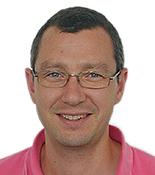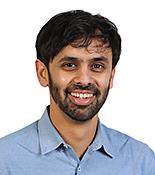
Maria Bernabeu Aznar
Group Leader and Co-chair of Infection Biology Transversal Theme
EditCharacterising pathogen interactions with the host at an atomic, molecular, and tissue level to tackle infection and antimicrobial resistance

Group Leader and Co-chair of Infection Biology Transversal Theme
EditMaria Bernabeu’s research focuses on the study of malaria pathogenesis using bioengineered 3D blood-brain barrier models. The primary objective is to identify vascular inflammatory and barrier disruption mechanisms caused by P. falciparum-iRBC or immune cells during severe disease. Since rodent severe malaria models do not recapitulate P. falciparum cytoadhesion to endothelial cells, Maria harnesses the use of novel multi-cellular human in vitro cultures that replicate the biochemical and mechanical cues of the brain microvasculature. To gain deeper insights into the malaria pathogenic mechanisms, her group employs vascular functional assays, advanced imaging techniques, including confocal, X-ray, and volume EM, in combination with transcriptomic approaches to understand the molecular signalling pathways altered during severe malaria infections.

Group Leader and Co-chair of Infection Biology Transversal Theme
EditJan Kosinski’s group specialises in infection biology, with a focus on the interactions between the influenza virus and host cells during nuclear replication. Their approach integrates structural and systems biology, in-cell cryo-electron tomography, fluorescence imaging, and computational methods. They also apply their computational skills to collaborative research on the Lassa virus. Additionally, their work includes cryo-electron tomography studies of Giardia lamblia. In collaboration with external partners, the group engages in structural analyses of bacterial secretion systems and malaria parasites. Each pathogen brings its unique set of questions. However, at the core of all the group’s projects is a unified goal: to unravel the molecular and cellular mechanisms that underpin how pathogens infect humans and to understand the intricate structural architecture of the pathogen’s virion or cell.

Group Leader and Co-chair of Infection Biology Transversal Theme
EditEva Kowalinski’s research aims to unravel the mechanisms of molecular machines in the cell. Her lab focusses on the understanding of RNA processing pathways in eukaryotic Trypanosoma parasites, which cause a range of fatal diseases in humans and lifestock. Her team uses advanced techniques such as X-ray crystallography and cryo-electron microscopy to unravel three-dimensional structures of key RNA processing enzymes and complexes in these parasites. In a multidisciplinary approach, she combines structural techniques with bioinformatics and molecular and cell biology techniques to gain a comprehensive understanding of the RNA-related pathways in Trypanosoma.
John Lees’ infection biology research impacts two main areas: Understanding the evolution of pathogenesis and transmission using computational methods, and creating bioinformatic methods and models to democratise computational infection biology research. Infection systems are an ideal place to answer fundamental evolutionary questions such as: Do evolutionary processes repeat themselves? At what timescales do modes of evolution dominate? Can we predict future evolution? His group uses overlapping methods to do this: mathematical modelling; statistical genetics; real-time genomic epidemiology; within-host diversity and adaptive sequencing; and high performance programming techniques. Newer projects include using generative AI to design genomic surveillance of pathogens, and combining genome and proteome function and structural information to improve vaccine design. His work often has emphasis on respiratory bacterial pathogens and the Streptococcus genus. But he is increasingly interested in pathogen-agnostic methods which span viral, bacterial, and eukaryotic pathogens.

Head of Molecular Systems Biology
EditNassos Typas’ research focuses on microbial systems biology, using high-throughput genetics and other systems-based approaches to study interactions of bacteria with the host and medication. Within this realm of work the group has been studying the way intracellular bacterial pathogens, such as Salmonella, survive and remodel the host environment, as well as how antibiotics can be combined to make more efficient treatments and delay development of resistance. The group also does innovative work on infection in the context of the microbiome, which has revealed the impact antibiotics have on commensal bacteria, and ways to mitigate this collateral damage. By integrating experimental and computational approaches, the Typas group aims to deepen our understanding of microbial communities, offering insights into infection biology and antimicrobial strategies. Their research represents a significant leap toward elucidating bacterial networks and devising effective therapies against infectious diseases, making them key contributors to advancing infection biology and microbial therapy development.

Administrative Assistant (TT)
EditLizette De Paula completed her education in the Netherlands Antilles, earning a Bachelor’s degree in Business Administration from the University of the Netherlands Antilles. Her focus and expertise revolve around optimizing customer service and offering exceptional managerial support.

Grant writer & Project Manager
EditBorja Esteve is a skilled science writer with more than 10 years of international experience (Spain, Austria, USA, UK) in academia, working on mathematical modelling, networks, comparative anatomy, evo-devo, and genomics. In addition to his work as grant writer, he has served as expert evaluator for the EU Marie Skłodowska-Curie Actions and the Human Frontiers Science Program. His role is to help members with external funding applications and offer support to chairs implementing the transversal theme initiatives.

Senior Team Leader – Protein Sequence Resources
EditAlex Bateman’s research on the evolution and function of bacterial cell surface proteins aims to understand host-pathogen interactions. Identifying and analysing adhesive proteins may provide new targets for vaccine development and therapeutic interventions. By leveraging deep learning and AlphaFold, they are at the forefront of uncovering the structure and function of these rapidly evolving proteins, with promising implications for combating bacterial infections.

Group Leader
EditSagar Bhogaraju’s research explores how pathogenic bacteria, like Legionella pneumophila, manipulate the host’s ubiquitination pathways to evade immune responses and facilitate infection. Their research on unique ubiquitination mechanisms and the structural analysis of bacterial effector proteins offers novel insights into the molecular strategies of pathogens, potentially leading to new therapeutic targets against Legionnaires’ disease and beyond.

Group Leader
EditMathieu Boulard’s research in infection biology aims at understanding the role of epigenetic gene silencing during the adaptive immune response. His approach combines ultra-low input epigenomic profiling with precision genomic engineering. In collaboration with the Pace group (IRCCS, Italy), Boulard investigates how bacterial infections elicit epigenetic memory in immune cells; their results have the potential to enhance vaccine efficacy.

Staff Scientist
EditMatthew Bowler’s research focuses on exploring the host reaction to infection and on how the intracellular parasite Toxoplasma gondii can invade and persist in its host at the molecular level. His work on the inflammatory response, using cryoEM and other biophysical techniques, has unveiled the mechanism of MAP kinase activation in response to infection and his research on host/pathogen interactions has expanded into high resolution imaging using X-rays and electrons. He has been designing, constructing and developing synchrotron beamlines for macromolecular crystallography since 2007. With a particular interest in automating complex experiments, he developed the scientific case and beamline design for MASSIF, the world’s first beamline to fully automate macromolecular crystallography experiments with complex sample handling robotics coupled to algorithms to locate samples and collect optimised data sets – supporting many drug design projects.

Team Leader, Data Coordination and Archiving
EditGuy Cochraine leads the European Nucleotide Archive (ENA). The ENA’s role in providing a comprehensive repository for nucleotide sequence data enables groundbreaking research into pathogens, disease surveillance, and vaccine development. His work ensures the accessibility of crucial data for understanding and combating infectious diseases globally.

Group Leader
EditGautam Dey employs an integrative research approach that combines comparative genomics, cell biology, and experimental evolution to explore the fundamental principles governing nuclear organisation and dynamics over evolutionary time. He has recently established a collaboration with Markus Ganter at Heidelberg University Hospital, which aims to understand the plasticity of nuclear cycling dynamics in response to the environment using Plasmodium falciparum, the causative agent of malaria. During the blood stage of infection, P. falciparum nuclei undergo multiple rounds of asynchronous division, without cytokinesis, resulting in a transient multinucleated cell. These asynchronous divisions are hypothesised to balance replication speed with resource availability. Leveraging advanced techniques such as high-resolution live cell imaging and tools from molecular, chemical, and cell biology, the project aims to unravel the environmental influence on the cell cycle network. To complement these findings, comparative analyses involving the free-living slime mold, Physarum polycephalum, will be utilised to assess the degree of conservation in the mechanisms that drive proliferation. This comparative approach sheds light on the divergent biology of the malaria parasite, offering potential insights for the development of intervention strategies.

Group Leader
EditNick Goldman’s Group focuses on mathematical models, statistics, and algorithms for molecular evolution and Next Generation Sequencing. Their research in infection biology centers on gene and genome evolution, including using machine learning (ML) to identify positive selection in genes. This approach enhances understanding of viral and bacterial evolution, especially in identifying key regions in pathogens’ gene sequences. Their current work in whole genome evolution handles pandemic-scale datasets, significantly larger than traditional phylogenetic analysis capabilities. Prompted by the COVID-19 pandemic’s vast viral genome data, they develop methods to infer evolutionary trees for over a million viral genomes. The Group is expanding these techniques to related areas like confidence measures in phylogenies, Bayesian phylogenetics, and phylogeography.

Visiting Group Leader (Outgoing)
EditJanosch Hennig conducts research in infection biology, focusing on the TRIM E3 ligase protein family, which is crucial in antiviral defence. A key objective of his research is to unravel the RNA-dependent mechanisms of TRIM25 in antiviral activities. His approach combines the precision of structural biology and biophysics with unique insights from cell biology and viral infection experiments. His work is further enriched by robust multinational collaborations, notably with the MRC-Centre for Virus Research in Glasgow. Such partnerships provide Hennig’s team with invaluable, direct insights into the intricate molecular interactions between host and pathogen.

Head of Light Imaging Facility
EditAlvaro Crevenna is the Head of the Light Imaging Facility, which can provide invaluable support for infection biology research. His facility’s capabilities in visualising host-pathogen interactions at unprecedented resolutions facilitates critical discoveries in understanding the mechanisms of infection and immune response.

Visiting Associate Group Leader
EditLandau’s labs research primarily focus on the virulent and antimicrobial aspects of amyloids, offering pioneering insights at the atomic level into their structure-function dynamics. Their work has unveiled a significant diversity in functional fibril structures, including the identification of cross-α amyloid fibrils and a novel fibril secondary structure switching mechanism. These findings have broadened the scope for investigating amyloid-related toxicity, action mechanisms, regulation, and interactions. The focus of the research extends to understanding the potential links between microbes, their amyloids, and the onset of neurodegeneration and amyloidosis through diverse molecular and signalling pathways.

Head of Molecular Systems Biology
EditJulia Mahamid’s research in infection biology is characterised by her innovative use of integrated structural biology techniques, particularly cryo-electron tomography of intact cells. Her group’s work spans three key areas: unravelling the molecular mechanisms of Mycoplasma pneumoniae infection by characterising its membrane proteome; investigating the dynamics of persistent viral replication factories based on bimolecular condensates in RNA viruses, with a focus on changes triggered following stress to the host; and exploring the protein synthesis machinery in human cells under various states, including viral infections. Julia’s approach, combining in-cell structural biology with a multitude of cell biology, biochemistry and mass spectrometry methods, uniquely positions her to provide profound insights into infection processes from atomic scale to the whole cell level.

Team Leader
EditSimone Mattei’s work delves into a molecular-level exploration of the life cycles of unicellular protozoan parasites and enveloped viruses. He utilises cryogenic correlative light and electron microscopy (cryo-CLEM) techniques and in situ cryo-electron tomography to provide structural insights. His research focus includes the functional and structural analysis of large molecular complexes. These complexes are crucial in processes such as the editing of mitochondrial mRNA, the development of mitochondrial ribosomes, and the mechanisms of invasion and avoidance used by intracellular parasites. Mattei’s multi-disciplinary team—comprising molecular biologists, physicists, software engineers, and image analysts—collaborates with internal and external scientists to develop and apply sophisticated imaging methods. These methods aim for automated and intelligent pinpointing of specific areas within their natural cellular environments.

Head of Crystallisation Facility
EditJose Marquez’s research interest is on the structural analysis of processes with relevance in biomedicine. His Team has a strong focus on the development of new technologies in macromolecular crystallography and applies these technologies to the identification and development of small-molecule inhibitors against promising, novel therapeutic targets from human pathogens. His Team operates the High-Throughput Crystallization Laboratory (HTX Lab) in Grenoble which provides access to automated protein-to-structure pipelines, as well as X-ray based high throughput Ligand and fragment screening based on the CrystalDirect technology and the CRIMS software.

Group Leader
EditEvangelia Petsalaki’s research integrates multi-omics data and network biology to decode context-specific human cell signalling regulation. Her group aims to map the complex architecture of human cell signalling networks, focusing on how these networks adapt during external perturbations. A key aspect of their work is exploring pathogen interactions with human signalling processes, crucial for understanding infection and proliferation mechanisms. Petsalaki’s team has identified shared linear motifs between humans and viruses, crucial for viral hijacking of human cells, which was achieved by combining sequence-level motif discovery, structural bioinformatics, and genomic analysis. In collaboration with the Ivarsson group (Uppsala University), they have unveiled linear motif-based interactions across RNA viruses and human domains, identifying distinct network signatures of viral infection. Currently, Petsalaki’s team is merging population genomics, structural bioinformatics, and network biology to uncover motifs associated with gut infections from diverse bacteria. Her work on infection biology aims to unravel the intricacies of human and bacterial signalling during infection, enhancing our understanding of cellular communication and response mechanisms in health and disease.

Team Leader and Head of Electron Microscopy Core Facility
EditYannick Schwab’s research focuses on developing advanced multimodal 3D imaging techniques to study subcellular organization in complex biological systems. His team specializes in correlative imaging methods that combine fluorescence microscopy, X-ray imaging, and electron microscopy. By integrating Correlative Light and Electron Microscopy (CLEM), Volume CLEM, and Correlative X-ray and EM (CXEM), they enable targeted high-resolution observations of specific events or cell types within native contexts. Schwab’s group collaborates with EMBL’s Electron Microscopy Core Facility and various research teams to apply these techniques across multiple fields in Life Sciences. Current projects include investigating the morphological aspects of the malaria parasite life cycle and studying cerebral malaria pathogenesis using a bioengineered 3D brain microvasculature model. The team employs a combination of confocal microscopy, microCT, synchrotron-based X-Ray imaging, guided ultramicrotomy, and volume SEM to obtain detailed 3D ultrastructural insights into targeted regions of interest.

Group Leader and Senior Scientist
EditMatthias Wilmanns’ main research interest is on the molecular mechanisms of mycobacterial secretion. Pathogenic mycobacteria comprise distinct type VII secretion machineries that are unrelated to other bacterial secretion systems. These systems are key components for mycobacterial growth and infection. Using an integrative structural biology approach, our group has provided structural insight into the complete ESX-5 secretion apparatus. Following the initial low-resolution structure, we have recently determined its high-resolution structure, revealing the substrate gating segment on the cytosolic side, the central pore that crosses the membrane, and a peculiar arrangement on the periplasmic side. These findings provide ample opportunities to functionally study the overall secretion process.

Genomics Software Develop Project Lead
EditDavid Yuan focuses on large-scale genomic analysis and computational algorithms to systematically analyse over five million SARS-CoV-2 genomes using federated high-performance computing and cloud computing. His team has adapted their novel pathogen analysis system to examine all Monkeypox virus genomes submitted to the International Nucleotide Sequence Database Collaboration in early 2023. Recently, they initiated a project in collaboration with Cambridge University and the Wellcome Sanger Institute to enhance pairwise and multiple sequence alignment using quantum computing algorithms and Phi X 174 and SARS-CoV-2 as model organisms.

Group Leader
EditJudith Zaugg’s research in infection biology centres on unravelling the gene regulatory mechanisms underlying cellular differentiation and response to pathogens in immune cells, notably T-cells and macrophages. Their approach involves dissecting regulatory pathways that orchestrate diverse cellular outcomes within immune cells. Notably, Judith’s group develops advanced computational tools and single cell technologies tailored to integrate expression and chromatin accessibility data. These tools and technologies facilitate an in-depth investigation of gene regulatory networks. By identifying key transcription factors and enhancers, the group aims to unveil the complex mechanisms governing cellular differentiation and response. This exploration not only sheds light on fundamental immune cell responses but also delves into mechanisms governing sex bias in immune cell function, thereby significantly advancing the field of infection biology research.